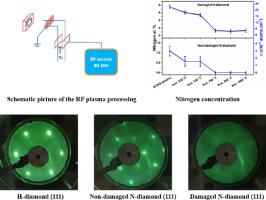当前位置:
X-MOL 学术
›
Surf. Sci.
›
论文详情
Our official English website, www.x-mol.net, welcomes your
feedback! (Note: you will need to create a separate account there.)
Nitrogen terminated diamond (111) by RF(N2) plasma – chemical states, thermal stability and structural properties
Surface Science ( IF 2.1 ) Pub Date : 2021-01-01 , DOI: 10.1016/j.susc.2020.121741 Mohammed Attrash , Mohan Kumar Kuntumalla , Shaul Michaelson , Alon Hoffman
Surface Science ( IF 2.1 ) Pub Date : 2021-01-01 , DOI: 10.1016/j.susc.2020.121741 Mohammed Attrash , Mohan Kumar Kuntumalla , Shaul Michaelson , Alon Hoffman

|
Abstract Nitrogen terminated diamond (111) (N-diamond) is suggested to have benefits to near-surface negative nitrogen vacancy (NV−) centers in diamond. To this end, better understanding of defects formation and nitrogen bonding on N-diamond (111) is important. However, there are no studies of N-diamond (111) surface. In this study, we report preparation of N-diamond (111) surface, and evaluation of its thermal stability, chemical states and structural properties. The N-diamond was produced by exposing diamond (111) to radio frequency (RF) nitrogen plasma at two different conditions expected to result in different levels of near surface damage due to the interaction of the activated nitrogen with the diamond surface. X-ray photoelectron spectroscopy (XPS) shows that the amount of incorporated nitrogen on diamond (111) surface differs for these two plasma conditions and is lower than obtained on diamond (100) for the same exposure conditions. Moreover, the thermal stability of nitrogen on non-damaged N-diamond is lower than 700°C as determined by low energy electron diffraction and XPS. The N-diamond (111) surface prepared by non-damaging plasma conditions exhibits a low defects density and well-defined structure, which may pave the way to control the shallow NV− charge state and magnetic spin properties in the near surface region of (111) oriented diamond.
中文翻译:

由 RF(N2) 等离子体制成的氮端金刚石 (111) – 化学状态、热稳定性和结构特性
摘要 氮封端金刚石 (111) (N-金刚石) 被认为对金刚石中的近表面负氮空位 (NV-) 中心有好处。为此,更好地了解 N-金刚石 (111) 上的缺陷形成和氮键很重要。然而,没有关于 N-金刚石 (111) 表面的研究。在这项研究中,我们报告了 N-金刚石 (111) 表面的制备,并评估了其热稳定性、化学状态和结构特性。N-金刚石是通过在两种不同的条件下将金刚石 (111) 暴露于射频 (RF) 氮等离子体来生产的,由于活化的氮与金刚石表面的相互作用,预计会导致不同程度的近表面损伤。X 射线光电子能谱 (XPS) 表明,对于这两种等离子体条件,金刚石 (111) 表面上掺入的氮量不同,并且低于在相同曝光条件下在金刚石 (100) 上获得的氮量。此外,通过低能电子衍射和 XPS 测定,氮在未损坏的 N 金刚石上的热稳定性低于 700°C。通过非破坏性等离子体条件制备的 N 金刚石 (111) 表面显示出低缺陷密度和明确定义的结构,这可能为控制近表面区域的浅 NV− 电荷态和磁自旋特性铺平道路 ( 111) 定向金刚石。根据低能电子衍射和 XPS 测定,氮在未损坏的 N 金刚石上的热稳定性低于 700°C。通过非破坏性等离子体条件制备的 N 金刚石 (111) 表面显示出低缺陷密度和明确定义的结构,这可能为控制近表面区域的浅 NV− 电荷态和磁自旋特性铺平道路 ( 111) 定向金刚石。根据低能电子衍射和 XPS 测定,氮在未损坏的 N 金刚石上的热稳定性低于 700°C。通过非破坏性等离子体条件制备的 N 金刚石 (111) 表面显示出低缺陷密度和明确定义的结构,这可能为控制 ( 111) 定向金刚石。
更新日期:2021-01-01
中文翻译:

由 RF(N2) 等离子体制成的氮端金刚石 (111) – 化学状态、热稳定性和结构特性
摘要 氮封端金刚石 (111) (N-金刚石) 被认为对金刚石中的近表面负氮空位 (NV-) 中心有好处。为此,更好地了解 N-金刚石 (111) 上的缺陷形成和氮键很重要。然而,没有关于 N-金刚石 (111) 表面的研究。在这项研究中,我们报告了 N-金刚石 (111) 表面的制备,并评估了其热稳定性、化学状态和结构特性。N-金刚石是通过在两种不同的条件下将金刚石 (111) 暴露于射频 (RF) 氮等离子体来生产的,由于活化的氮与金刚石表面的相互作用,预计会导致不同程度的近表面损伤。X 射线光电子能谱 (XPS) 表明,对于这两种等离子体条件,金刚石 (111) 表面上掺入的氮量不同,并且低于在相同曝光条件下在金刚石 (100) 上获得的氮量。此外,通过低能电子衍射和 XPS 测定,氮在未损坏的 N 金刚石上的热稳定性低于 700°C。通过非破坏性等离子体条件制备的 N 金刚石 (111) 表面显示出低缺陷密度和明确定义的结构,这可能为控制近表面区域的浅 NV− 电荷态和磁自旋特性铺平道路 ( 111) 定向金刚石。根据低能电子衍射和 XPS 测定,氮在未损坏的 N 金刚石上的热稳定性低于 700°C。通过非破坏性等离子体条件制备的 N 金刚石 (111) 表面显示出低缺陷密度和明确定义的结构,这可能为控制近表面区域的浅 NV− 电荷态和磁自旋特性铺平道路 ( 111) 定向金刚石。根据低能电子衍射和 XPS 测定,氮在未损坏的 N 金刚石上的热稳定性低于 700°C。通过非破坏性等离子体条件制备的 N 金刚石 (111) 表面显示出低缺陷密度和明确定义的结构,这可能为控制 ( 111) 定向金刚石。











































 京公网安备 11010802027423号
京公网安备 11010802027423号